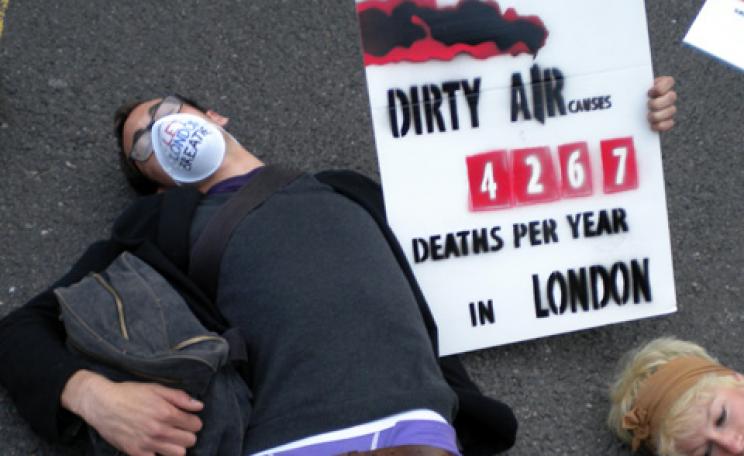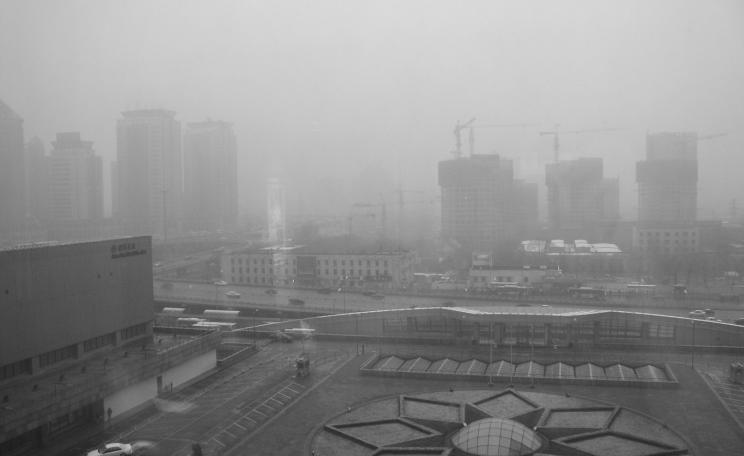Air pollution – seen by most of the population as an outdated public health issue – has returned to mainstream media attention in recent months. March saw a widely-reported publication from the Environmental Audit Committee, which said the UK should be 'ashamed' of its poor air quality.
There has been debate in the House of Lords, and threats from the European Commission of multi-million euro penalties for half-hearted British efforts which have failed to meet mandatory air quality targets set five years ago. The BBC and other outlets have also investigated fears that the London Olympics will be jeopardised by a blanket of pollutants spewed from congested traffic.
Meanwhile, activists have employed new media technologies to increase air pollution’s profile. The Campaign for Clean Air in London, for example, has generated interest through a Twitter campaign aimed at exposing a 'government cover-up' over annual pollution-caused deaths.
There is even a new air quality iPhone app from Kings College London, which offers Londoners real-time updates on kerbside pollution levels in their area. It gained 6000 subscribers in its first two weeks.
Growing awareness
The driving force behind these trends is an ever-increasing medical understanding of air pollution’s impact. Certain groups were already known to be badly affected by poor air quality, including asthmatics and those living near to major roads or construction sites, but awareness of wider impacts was low.
Four years ago Defra commissioned a study to examine what a Citizen’s Jury thought about air pollution. The sample group recorded that they had 'no sense of what "good" quality air is'. Indeed, most participants admitted that they had never explicitly thought about air quality.
It is becoming more difficult to avoid the issue. Crucially, new research is linking poor air quality to heart disease and impaired lung function on an unprecedented scale.
But this attention has not yet translated into the widespread public concern needed to force political action. This is proving difficult with a public sceptical of an invisible health threat, and medical research into the matter still at early stages.
Poor air quality is now thought to cause 35,000 or more premature deaths in the UK each year. If it is to be tackled, a greater public awareness of medical research into air pollution – including its shortcomings – is necessary.
The science
So what is this new research? As has been widely reported, long-term exposure to traffic-generated pollution is now strongly linked with cardiovascular and respiratory disease. This is the conclusion drawn from numerous prominent epidemiological studies.
One of the first of note was the result of work by a Dutch team based at the University of Utrecht in 2002. They used a large random sample of people approaching retirement age from across the Netherlands to compare heart and lung disease mortality with traffic exposure. Over a 12-year period, those living within 50 metres of a major urban road were found to be almost twice (1.95 times) as likely to die from cardiopulmonary disease.
A more recent German study carried out in 2007 at the University of Duisburg–Essen – located in the highly industrialised and densely populated Ruhr region – unveiled similar trends. It noted that calcification (the build-up of calcium deposits) within the coronary arteries increased alongside proximity to major roads. Residents living twice as close to a major road as their neighbours could expect to suffer on average 7 per cent higher levels of calcification, which is linked to heart attack and stroke.
In addition to heart and lung disease, several studies have looked at the impact of traffic pollution on birth outcomes. A University of British Columbia team in 2008 assessed over 70,000 births across three years, and found cases of small gestation age size and low birth weight rose by 26 per cent and 11 per cent respectively within 50 metres of highways. It also found a correlation between exposure to particulate matter – which is generated by brake and tyre wear as well as by engines – and premature births. All of these outcomes have long-term associations with developmental disability and chronic lung disease.
A 'modern type of air pollution'
This selection is representative of a wider consensus being forged by research. The studies were all internationally commended by a recent report from the US-based Health Effects Institute (HEI). The report examined over 700 peer-reviewed studies and included only those meeting rigorous scientific standards.
The HEI’s criteria for inclusion required compensatory measures against 'confounding factors' - such as socio-economic background and smoking habits - which tend to skew results. However, the number of existing studies meeting these requirements is relatively small, partly because studies of this form of air pollution have only recently become a research focus.
'This new problem of so many cars on the road, and particularly the modern diesel cars producing very, very small particles which can penetrate deep into our lungs, was not really appreciated until the 1990s,' says Professor Frank Kelly, a leading health expert with Kings College London. 'It’s a modern type of air pollution issue that we’re now having to deal with.'
Only 15 years have been spent on looking at this type of transport pollution as a public health challenge. For the big public health questions – the link between smoking and lung cancer, for example – assembling sufficient data to make authoritative statements takes a number of decades.
Given this limited amount of qualifying studies, the HEI report itself only offers one watertight finding: that exacerbation of existing asthma conditions is caused by high traffic exposure. Though a concern for many of the nation’s five million asthmatics, this is not the new information that might motivate politicians to take broader action, and has been unofficially described by one of the report’s authors as the 'tip of the iceberg'.
Experts say further analysis will confirm additional findings sooner rather than later, with heart disease the principle public health hazard.
Complications
Doing the science is not easy, however, and there are a number of complications to contend with.
Trends of urbanisation and increased prosperity – which drives the greater uptake of personal motorised transport – are fairly universal in increasing exposure to traffic pollution. But the level and make-up of the pollutants faced by different populations vary substantially, as do the characteristics of the populations themselves.
Lab-based toxicology struggles to emulate these diverse conditions in any useful way. On the other hand, epidemiological studies that simply compare personal health with distance lived from a major road are deeply inadequate. For instance, much of an individual’s daily exposure can come from the short periods of time spent in highly-polluted micro-environments, such as busy roads or underground metro systems.
A further complication is the selection of a surrogate (the measurable indicator for overall levels of traffic pollution). Elemental carbon, benzene and nitrogen oxide (NOx) are most common, but none are ideal as none are entirely specific to traffic. They collectively account for over 40 per cent of all-source emissions.
Instead the better studies as selected by the HEI report use a hybrid approach incorporating additional data such as land-use models, questionnaires on personal activity, information on weather patterns, micro-monitoring of a wide range of pollutants and some toxicological work. This causes comprehensive studies to be expensive, and therefore few are undertaken.
What next?
The question really is what to do with the emerging findings, and how to use them to improve matters.
Statistics are frequently employed. The recent figure of 51,500 premature deaths per year in the UK alone, from the European Topic Centre on Air and Climate Change, has been widely cited by the media. It was seized upon by the parliamentary committee report last month to emphasise Government failings.
This statistic conveys the severity of recent research findings, and is based on a broadly accepted (if crude) coefficient for estimating mortality using concentration of particulate matter (an increase in mortality rates of 6 per cent for each extra 10μg of PM 2.5 per cubic metre of air). However, it also uses an unusual high-resolution modelling approach, and should be recognised as a top-end estimate.
Efforts to highlight air pollution’s costs in both monetary and human life terms must contend with such ambiguities. But they certainly have their place. For instance, the parliamentary report in March also drew on Institute of Occupational Medicine research to describe a hypothetical 7-8 month gain in average UK life expectancy if all airborne particulate matter were to be eliminated. This was compared with 1-3 month and 2-3 month gains through eliminating traffic accidents and passive smoking respectively (the ranges represent the smaller impacts these would have on women).
It is true that the models used to calculate these figures are not directly comparable, and that confounding factors remain. But it is also the case that the 7-8 month average conceals a much higher figure of around 9 years lost by particularly exposed or sensitive individuals. It also ignores the non-mortality health benefits eliminating particulate matter would deliver.
Science rarely deals in absolutes, and it is of course important that inevitable complexities are both visible and accounted for. But while our understanding increases, any certainty of gauging air pollution’s full impact on public health remains years away. It would be a dangerous game to wait so long before taking action.
Andrew Marszal is a freelance journalist
| READ MORE... | |
 |
NEWS Farm pesticides linked to skin cancer Large-scale study highlights agricultural chemicals as a possible risk factor behind rising rates of melanoma in the US |
 |
INVESTIGATION How long until health foods become illegal? A huge number of UK citizens take food supplements or buy health food products, yet new legislation threatens to either remove these items from our shelves, restrict their dosages or ban them from making any health claims |
 |
NEWS Air pollution death toll could hit 50,000 a year, say MPs UK’s poor air quality is a bigger killer than passive smoking, road traffic accidents and obesity says parliamentary committee |
 |
NEWS 'Fat tax' needed to tackle obesity A tax on unhealthy foods would be more effective at tackling obesity than making healthy foods cheaper but could hit the poorest the hardest |
 |
INVESTIGATION What is the Pill doing to our bodies and planet? It was the drug that fuelled the sexual liberation of the 1960s, but what price are we paying for our love of the contraceptive Pill? |






